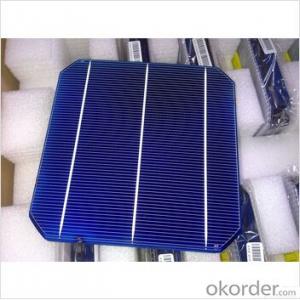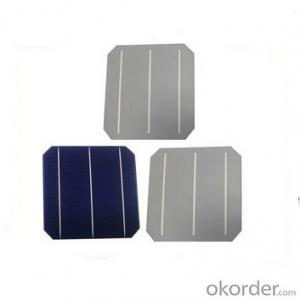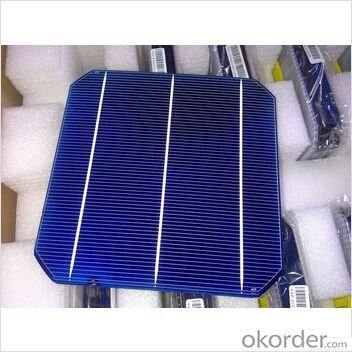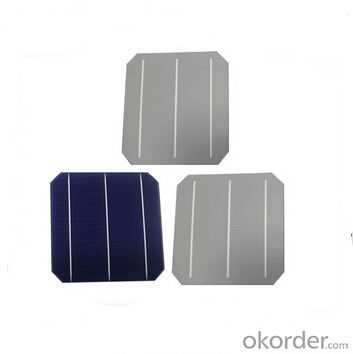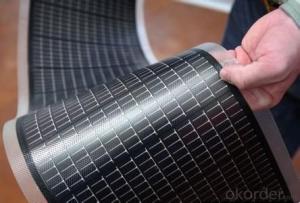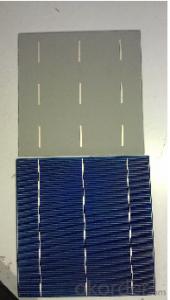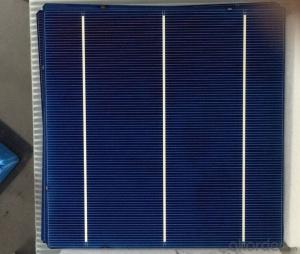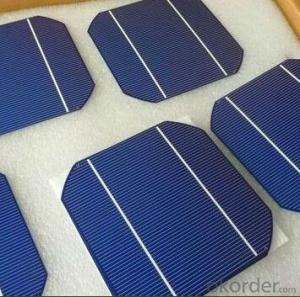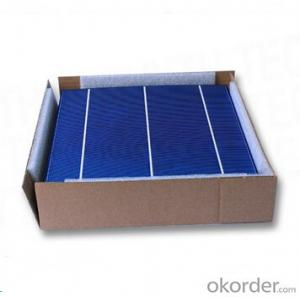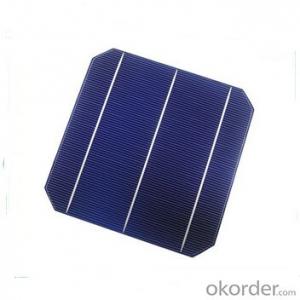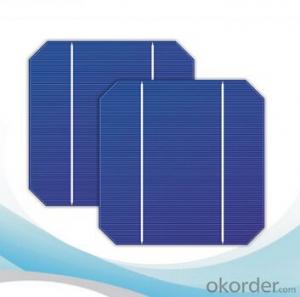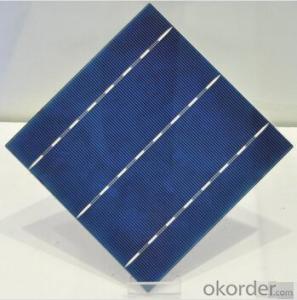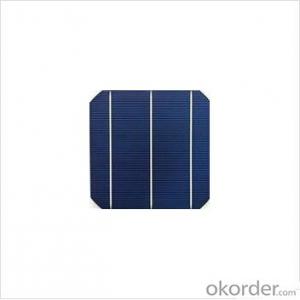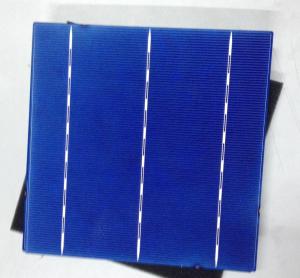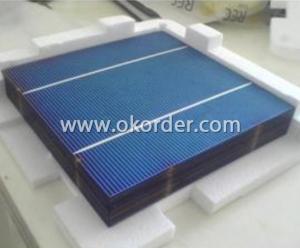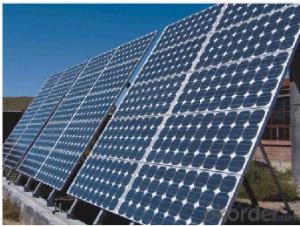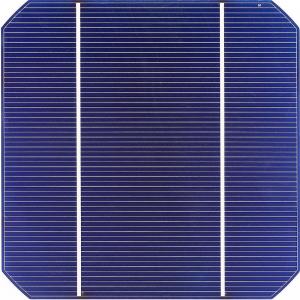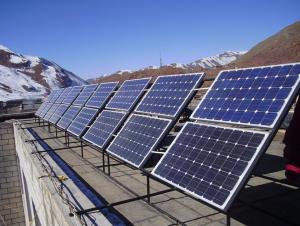Solar Cells House High Quality Monocrystalline Solar Cells 18.60-18.80
- Loading Port:
- Shanghai
- Payment Terms:
- TT OR LC
- Min Order Qty:
- 1000 pc
- Supply Capability:
- 1000000 pc/month
OKorder Service Pledge
OKorder Financial Service
You Might Also Like
Solar Cells:
Solar cells is made by solar wafer, it has three categories of solar cell right now, monocrystalline polycrystalline and thin film,These cells are entirely based around the concept PNjunction, which is the critical part of solar module, it is the part that can convert the light energy into electricity, the thickness is from 180um to 200um, with even busbars to conduct electricity, textured cell can decrease diffuse reflection; they are often electrically connected and encapsulated as a module. Photovoltaic modules often have a sheet of glass on the front (sun up) side, allowing light to pass while protecting semiconductor wafers from abrasion and impact due to wind-driven debris, rain, hail, etc. Solar cells are also usually connected in series in modules, creating an additive voltage. Connecting cells in parallel will yield a higher current;With high quality and stable quality. Our Cells can greatly improve the performance of Solar Modules.
Features:
High conversion efficiencies resulting in superior power output performance.
Outstanding power output even in low light or high temperature conditions
Optimized design for ease of soldering and lamination
Long-term stability,reliability and performance
Low breakage rate
Color uniformity
Solar Cells Advantage:
• High efficiency and stable performance in photovoltaic conversion.
• Advanced diffusion technique ensuring the homogeneity of energy conversion efficiency of the cell.
• Advanced PECVD film forming, providing a dark blue silicon nitride anti-reflection film of homogenous color and attractive appearance.
• High quality metal paste for back surface and electrode, ensuring good conductivity, high pulling strength and ease of soldering.
• High precision patterning using screen printing, ensuring accurate busbar location for ease with automatic soldering a laser cutting.
Specifications:
Eff(%) | Pmpp(W) | Umpp(V) | Impp(A) | Voc(V) | Isc(A) | FF(%) |
18.60-18.80 | 4.45 | 0.532 | 8.360 | 0.630 | 8.880 | 79.240 |
18.40-18.60 | 4.40 | 0.529 | 8.321 | 0.629 | 8.860 | 78.960 |
18.20-18.40 | 4.35 | 0.527 | 8.284 | 0.628 | 8.841 | 78.608 |
Packaging & Delivery of Solar Cells
Carton Box Package and Deliver by air. It should be noticed that it should be avoid of water, sunshine and moist.
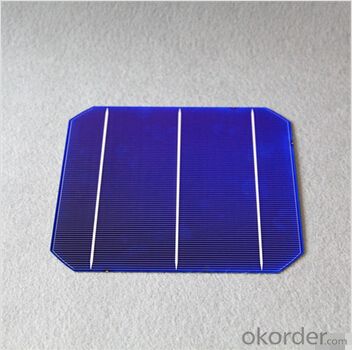
FAQ
We have organized several common questions for our clients,may help you sincerely:
①What price for each watt?
It depends on the efficiency of the solar cell, quantity, delivery date and payment terms.
②How long can we receive the product after purchase?
In the purchase of product within three working days, We will arrange the factory delivery as soon as possible. The pecific time of receiving is related to the state and position of customers.Commonly 7 to 10 working days can be served.
③Can you provide the peripheral products of the solar panels, such as the battery, controller, and inverter? If so, can you tell me how do they match each other?
Yes, we can, we have two companies for solar region, one is CNBM International, the other is CNBM engineering Co.
We can provide you not only the solar module but also the off grid solar system, we can also provide you service with on grid plant.
④What is your warranty of solar cell?
Our product can promise lower than 0.3% open box crack, we support claim after opening the box if it has crackm color difference or sth, the buyer should give pictures immediately, we can not accept the claim after the solar cell has assembled to solar panel.
• Timeliness of delivery
• ⑤How do you pack your products?
We have rich experience on how to pack the solar cell to make sure the safety on shipment, we could use wooden box or pallet as buyer's preference.
- Q: Can solar cells be used in hybrid systems?
- Yes, solar cells can be used in hybrid systems. Hybrid systems combine different sources of energy, such as solar, wind, or fossil fuels, to generate electricity. Solar cells can be integrated into these systems to harness solar energy and contribute to the overall power generation. This allows for a more sustainable and efficient energy production, reducing reliance on traditional energy sources.
- Q: Can solar cells be used to charge batteries?
- Yes, solar cells can definitely be used to charge batteries. Solar cells convert sunlight into electricity, which can be used to charge batteries for various applications such as powering small devices or storing energy for later use.
- Q: What is the maximum efficiency possible for a solar cell?
- The maximum efficiency possible for a solar cell, based on current technology, is around 44%.
- Q: Can solar cells be used in hotels?
- Yes, solar cells can be used in hotels to generate renewable and clean energy. They can be installed on the roofs or other suitable areas of hotels to capture sunlight and convert it into electricity, reducing the reliance on traditional energy sources and lowering utility costs.
- Q: Can solar cells be used for powering hospitals?
- Yes, solar cells can be used to power hospitals. Solar energy can be harnessed through solar panels or solar cells, and these can generate electricity to meet the power needs of hospitals. By utilizing solar power, hospitals can reduce their reliance on traditional energy sources, lower their operating costs, and contribute to a cleaner and more sustainable environment. However, the feasibility of using solar cells for powering hospitals depends on factors such as the hospital's energy demand, available space for solar panels, and the region's sunlight availability.
- Q: How do solar cells perform in high altitude locations?
- Solar cells tend to perform better in high altitude locations due to the thinner atmosphere. With less air to scatter and absorb sunlight, solar cells can capture more solar radiation, resulting in increased energy production. Additionally, the lower temperatures at higher altitudes can also enhance the efficiency of solar cells.
- Q: Can solar cells be used for desalination purposes?
- Yes, solar cells can be used for desalination purposes. Solar-powered desalination systems, such as solar stills and solar desalination plants, harness the energy from the sun to power the desalination process. This renewable energy source helps reduce the environmental impact of desalination and promotes sustainable water production.
- Q: Does solar cell cost less than the other power generation technology?
- It saves incredible cost because it is an infinite supply of energy.
- Q: Can solar cells be used to power water pumps?
- Yes, solar cells can be used to power water pumps. Solar cells convert sunlight into electricity, which can be used to power various devices, including water pumps. This is commonly done in remote areas where there is no access to electricity grids or in situations where using solar energy is more cost-effective and sustainable.
- Q: What is the impact of dust or dirt on solar cell performance?
- The presence of dust or dirt on solar cells can significantly impact their performance. As these particles accumulate on the surface of the cells, they create a barrier that reduces the amount of sunlight reaching the photovoltaic material. This obstruction leads to a decrease in the conversion of solar energy into electricity, resulting in a lower overall efficiency of the solar panels. Regular cleaning and maintenance are essential to ensure optimal performance and maximize the electricity generation from solar cells.
Send your message to us
Solar Cells House High Quality Monocrystalline Solar Cells 18.60-18.80
- Loading Port:
- Shanghai
- Payment Terms:
- TT OR LC
- Min Order Qty:
- 1000 pc
- Supply Capability:
- 1000000 pc/month
OKorder Service Pledge
OKorder Financial Service
Similar products
Hot products
Hot Searches
Related keywords
